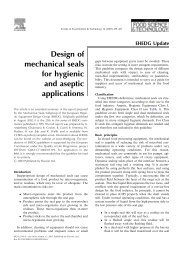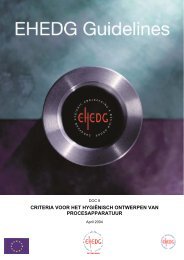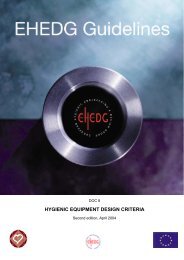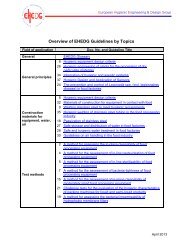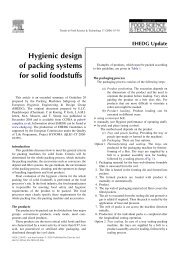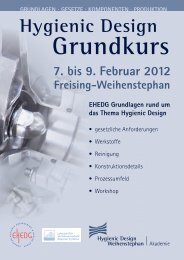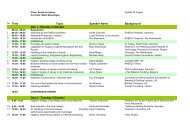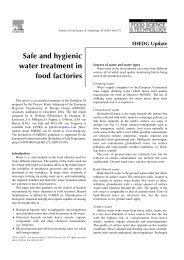Yearbook 2013/2014 - ehedg
Yearbook 2013/2014 - ehedg
Yearbook 2013/2014 - ehedg
You also want an ePaper? Increase the reach of your titles
YUMPU automatically turns print PDFs into web optimized ePapers that Google loves.
European Hygienic Engineering & Design Group<br />
Infection-free preparation of bacterial cultures<br />
The preparation and compounding of freeze-dried bacterial cultures available in powder form<br />
requires extremely high standards of hygiene. If the material is also deep frozen the mixing<br />
equipment must have very good insulation and meet increased strength requirements.<br />
Dipl.-Ing. Ludger Hilleke, amixon GmbH, D-33106 Paderborn, Phone: +49 5251 68 88 88-0, info@amixon.de,<br />
www.amixon.de<br />
Today, fermented specialities enhance nearly all of the most<br />
commonly produced dairy products. Whether in cheese,<br />
curd and yoghurt, or when used for improving meat, they<br />
can be found everywhere. However, the production of these<br />
powdery granular materials is a real challenge, especially in<br />
further processing environments, which demand a high level<br />
of cleanliness, quality of handling, and a granular dust-free<br />
structure.<br />
A determinant of the quality in this process is operation<br />
with the minimum of interruptions; in other words, as nearly<br />
continuously as possible. High-purity bacterial cultures form<br />
by cell division, and for industrial production, the aqueous<br />
suspension of bacteria is continuously diluted with nutrient<br />
solution. After a constant dwell time, the matured suspension<br />
is removed and washing processes follow. The cell division<br />
process does not stop until the extracted cultures are frozen.<br />
To facilitate handling, the cultures also are sometimes freeze<br />
dried, which produces a loose powder or granulate with bulk<br />
densities around 0.1 to 0.4 kg/dm 3 .<br />
In subsequent automated processing of bacterial cultures<br />
there is often a mixing process. Naturally, a quick result is<br />
desirable, with the mixing done in a way that avoids causing<br />
damage and that work efficiently under difficult conditions<br />
(i.e., differing filling degrees, bulk densities, particle sizes,<br />
rotational speeds, etc.). In addition, as a result of the<br />
alternating stresses that result from very high temperature<br />
changes in these processes, mixers must be specially<br />
designed to avoid fatigue cracks.<br />
Meeting all of these challenges of producing powderform<br />
freeze-dried bacterial cultures in a hygienic manner<br />
requires mixers that are designed with hygiene in mind.<br />
A good example is a single-shaft mixer whose mixing<br />
principle is based on a three-dimensional rearrangement,<br />
such as those produced by amixon GmbH (Figure 1). In<br />
such a mixer, the material in the periphery of the mixing<br />
chamber is screwed upwards and then flows downwards<br />
in the centre. The helical mixing tool performs mixing<br />
very gently at circumferential speeds of 0.2 to 0.9 m/s. A<br />
particularly useful feature is that the mixing process takes<br />
place independently of the filling level. In this respect the<br />
emptying process also takes place without segregation,<br />
even when it takes a long time or occurs while pulsating.<br />
The high degree of residue emptying assists in keeping the<br />
mixer highly sanitary.<br />
Figure 1. Example of a single-shaft mixer that can be used in the<br />
manufacture of powder-form freeze-dried bacterial cultures.<br />
Thorough cleaning of a processing plant in which mixing<br />
of powders occurs is also clearly essential. Avoiding<br />
contamination is both a determinant of quality and an<br />
absolute ‘must’ in producing foods free of allergens. One<br />
solution to this challenge is the automation of wet cleaning<br />
and drying of powder mixers. In one patented process, a<br />
clean-in-place (CIP) device is firmly installed on the mixing<br />
chamber and remains there permanently. For wet cleaning,<br />
the sealing plug in the mixing chamber opens and makes<br />
the space available for the motion of a rotating wash lance.<br />
The latter moves into the mixing chamber with translatory<br />
motion. With an applied water pressure of about 3.5 bar,<br />
the head rotates and three nozzles spray the entire mixing<br />
chamber interior. Depending on the size and execution of<br />
the mixer, three, four, or in some cases five, washing heads<br />
are necessary for wetting the entire mixing chamber and all<br />
parts of the mixing tool.<br />
After completion of the wet cleaning, drying is essential.<br />
Bearing in mind that the specific heat capacity of water is<br />
about nine times as great as that of stainless steel, the wet<br />
cleaning with hot water spontaneously heats up the mixer.<br />
This heat assists the steam stripping of the mixer. Additional<br />
hot air entering via an inlet through the main connection of<br />
the CIP device accelerates the drying process.<br />
The entire mixer and the CIP system are dried. Only then<br />
does the rotating lance move out of the mixing chamber and<br />
the sealing plug closes the container, gas-tight and liquidtight.



